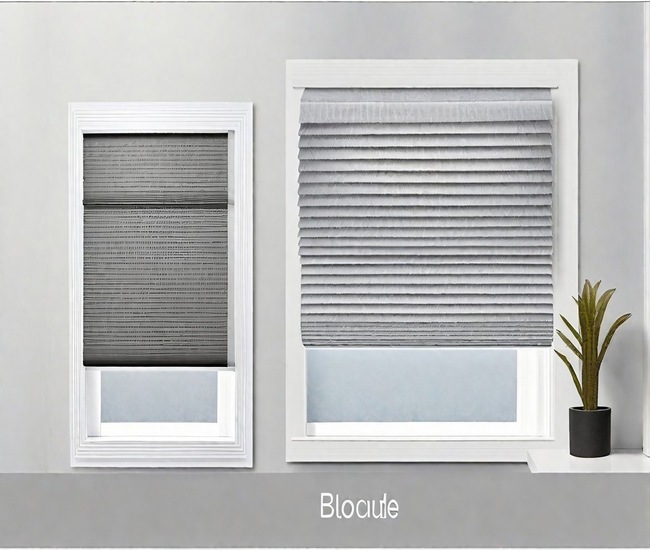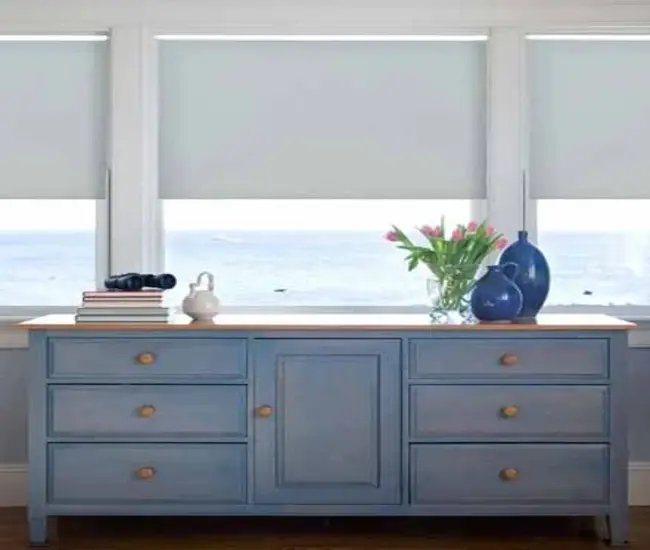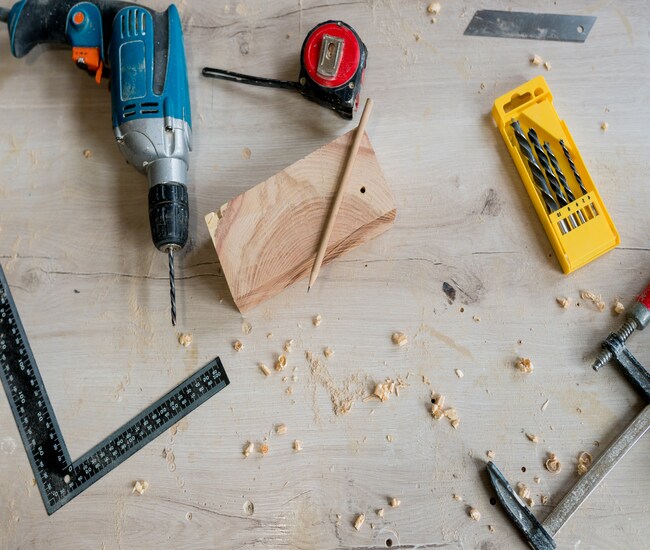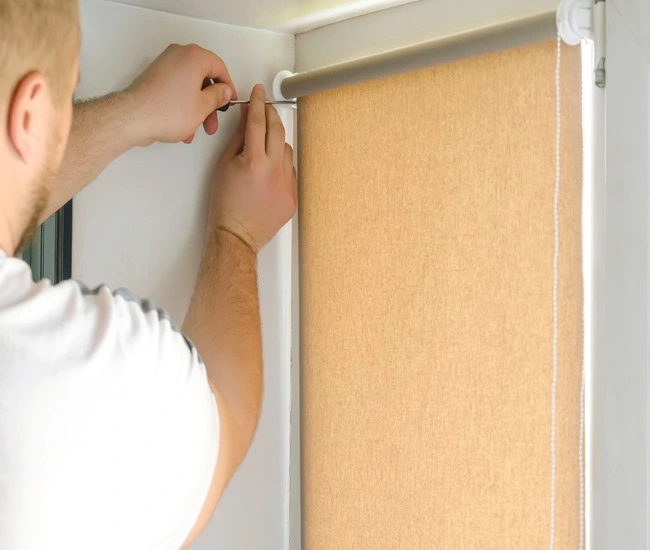When it comes to installing blinds, shades, shutters, and curtains, you have 2 mount options to choose from, inside mount and outside mount.
Inside mount for blinds, shades, and shutters refers to their installation inside the window frame, as opposed to outside or around the frame.
You’ll need to make the choice between the two when measuring your window. The type of mount will change the length and width of fabric needed.
The mount type determines where the brackets are attached and how the blind fits over the window.
Key Points
- Inside, outside, flush mount, and ceiling mount are different mounting options. Each type has its pros and cons.
- Inside mounts look sleek and save energy but offer less light control.
- Outside mounts are easier to install, block more light, but appear bulkier.
- Flush and ceiling mounts offer additional options for specific needs.
- Choose the mount based on window depth, type, and desired function.
- Proper care ensures your blinds work, last, and look their best.
- Mounting your blinds is a relatively easy process, but it’s important to follow the instructions that come with your particular product.
Inside Mount vs Outside Mount

Also referred to as face fixing, face fixed, face mount, or direct window mount, an outside mount involves installing the blinds to the face or front of the architrave, or above it. With the outside mount, the blind covers the entire window opening, extending past the height and diameter of the window space.
This type will give better light coverage and noise reduction for better sleep in your bedroom or nursery.
Inside Mount
An inside mount, also referred to as recess mount, involves attaching brackets to the inside of the window frame. The brackets can be placed almost anywhere on the top, sides, or the corner of the inside window frame.
An inside mount will give a sleeker look to the window.
But, with the inside mount, the room for error in measuring width, height, and depth is minuscule.
Other Mounting Types
Flush Mount
The flush mount is similar to the inside mount, except that the blind is completely recessed in the window frame, with nothing protruding out of the window frame.
Ceiling Mount
It is similar to the outside mount. In the ceiling mount, the brackets are attached to the ceiling.
Factors Affecting the Choice of a Mount Type for a Blind
Recess or Depth Requirement
If the window frame depth meets the product specifications when buying, you can install the shade inside the frame. Otherwise, you’ll need to go for an outside mount. For example, the minimum depth requirement for inside mounting Cordless 2” Faux Wood Blinds is 2 inches.
Types of Window Covering

The choice of specific mount type also depends on the type of window covering you are installing. For example, curtains will work better with an outside mount. On the other hand, sleeker roller shades will look and work better if installed inside the window frame.
Curb Appeal and Functionality
Your choice of a particular mounting type can affect both the decorative appeal and functionality of different types of blinds, including mini blinds, faux wood blinds, Roman shades, Roller shades, woven wood shades, cellular blinds, curtains, and shutters.
Type of Window
Sometimes, the type of window itself limits the mounting option. For example, sliding windows or sliding glass doors that are stacked in front of each other don’t allow enough space for attaching brackets directly to the window frame sash or glazing bead. So, you’ll need to go for recess or face mounts.
Similarly, recess mount would be inappropriate with windows having handles or hardware protruding into the window reveal space.
But how do you know which mount is right for your blinds? Keep reading to learn how to choose the right mount for your blinds, shades, shutters, and curtains.
How to Choose the Right Mount for Your Blinds

Can’t decide whether you need to choose an inside mount or outside mount for your window blinds, shades, and shutters? Here are some practical tips to help you with your decision.
Choosing the right mount for your blinds and shades can seem like a daunting task, but it doesn’t have to be.
These tips will be helpful.
Inside Mount
Inside mounts are the most popular choice, as they’re the easiest to install and offer a clean, finished look.
However, outside mounted blinds only work if your window frame is deep enough to accommodate the blinds.
Outside Mount
Outside mounts are a good option if you have shallow windows or want to add visual interest to your room. Outside mounts also make your windows look bigger, as you can add 3 to 4 inches of fabric to both width and height.
However, the outside mount will need more fabric, adding to the cost of your window treatment.
Flush Mount
Flush mounts are perfect for rooms with low ceilings, as they mount directly to the wall.
No matter which type of mount you choose, make sure to measure your windows carefully before making a purchase. With a little planning, you can find blinds that look great and function well in any space.
Pros and Cons of Inside Mounts for Blinds and Shades
Here are some pros and cons of inside mount for your blinds and shades:
Pros
- Sleek and Minimal Appearance: Inside mount blinds and shades offer a streamlined and modern look that can complement the interior decor of a room. They are a good choice for rooms with limited space, as they take up less room than outside mount blinds.
- Custom Fit: Inside mount blinds and shades are custom fit to the dimensions (width, height, and depth) of the window frame, so they can be a good choice for windows that are not a standard size or shape.
- Energy Efficiency: Inside mount blinds and shades can help to improve energy efficiency by providing an extra layer of insulation between the window and the interior of the room. This can help to reduce heating and cooling costs.
Cons
- Limited Light Control: Inside mount blinds and shades may not completely block out light, as they are installed within the window frame. They may also allow some light to leak in around the edges of the blinds, which can be a problem for people who need complete darkness or a blackout environment to sleep.
- More Window Depth Requirement: Inside mount blinds and shades may not be suitable for windows that have limited space for mounting, such as those with narrow window frames.
- Installation Difficulties: Installing inside-mount blinds and shades can be more challenging than outside-mount window treatments, as they require precise measurements and may need to be fixed with screws or other hardware that can be difficult to install.
Pros and Cons of Outside Mount for Window Blinds and Shades
In the case of outside mounting, the blinds, shades, shutters, or curtains are mounted outside or around the window frame. Here are some advantages and disadvantages of outside mount for shades:
Pros
- Maximum Light Control: Outside mount blinds and shades provide maximum light control and insulation as they cover the entire window opening. This makes them a great choice for bedrooms or other areas where light control is important.
- More Versatile: Outside mount blinds and shades can be installed on almost any window frame, regardless of the size or shape of the window. They are a more versatile option for a wide range of windows.
- Easy to Install: Installing outside-mount blinds and shades is generally easier than installing inside-mount window treatments. This is because you usually have more space to work with and there is less need to take precise measurements.
Cons
- Less Energy Efficient: Outside-mount blinds and shades do not provide the same level of insulation as their inside-mount counterparts. It is because they do not sit directly against the window. This can result in less energy efficiency, which could lead to higher heating and cooling costs.
- Less Sleek Look: Outside mount blinds and shades can appear bulkier and less streamlined than inside mount options, which may not fit the aesthetic of all your rooms.
- Visible Hardware: The hardware used to install outside mount blinds and shades may be visible, which could be a drawback for some homeowners who prefer a more seamless look.
Things to Consider Before Mounting Blinds and Shades
There are a few things to consider before mounting blinds and shades.
- Material: First, you need to decide what material you want your shades and blinds to be made from.
- Mechanism of Operation: Second, you need to decide how you want to operate your blinds and shades—manually or with motorized controls.
- Taking Measurements:

Finally, you need to take measurements of your windows so that you can choose the right size of blinds or shades.
With careful planning, the inside or outside mounted blinds can be a simple and effective way to improve the function of any room in your home.
How to Install your Blinds and Shades

Many blinds and shades are available as do-it-yourself (DIY) projects. Installation instructions vary depending on the type of blind or shade and the mounting style, but most blinds and shades follow a similar installation process.
- Gather Tools and Materials:

First, gather the necessary tools and materials.
- Prepare the Window Surface: Second, prepare the window surface by removing any old blinds or curtain rods.
- Install Mounting Brackets:

Third, install the brackets according to the manufacturer’s instructions.
- Hang Your Blinds or Shades: Fourth, insert the blind or shade into the brackets and secure it in place.
- Make Adjustments: Fifth, adjust the blind as needed until it is level and operating smoothly.
With a little effort, you can easily install your own blinds and achieve professional-looking results.
Installation Costs
The installation charges range from @20 to $100 per window for labor costs. If you avail installation packages for homes, the labor cost per window will get reduced to $10 to $15. For example, basic installation cost for 10 windows is $100 to $120.
How to Care for your Inside/Outside Mounted Blinds

Although blinds are a great way to add privacy, security, and style to your home, they can require quite a bit of care. Here are some tips on how to keep your blinds looking their best:
- Dusting: Dust regularly with a soft cloth or brush attachment.
- Vacuuming: Vacuum blinds monthly using the soft brush attachment.
- Washing: Clean blinds with a mild soap and water solution.
- Drying: Dry blinds thoroughly after cleaning. If blinds become wet, open them immediately to allow them to get dried.
Precaution: Avoid using harsh chemicals or abrasives.
By following these simple care instructions, you can keep your blinds looking like new for years to come.
Conclusion
Mounting blinds is a great way to improve the function and style of any room in your home. Blinds and shades are available in different mounting styles, materials, sizes, and colors to suit any need and interior decor style. Installation is relatively easy, but it’s important to take measurements and follow the manufacturer’s instructions carefully. With proper care, your blinds will last for many years.
Need More Help?
Still unsure which mount type will be more appropriate for the unique decorative and functional needs of your room? Get in touch for help now! Use 24/7 live chat or give us a call at (800) 863-6109 to contact our interior design experts for custom solutions.
